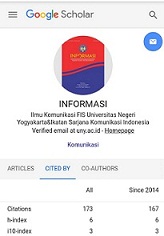The social harmony of local religious groups
DOI:
https://doi.org/10.21831/informasi.v50i1.30169Keywords:
Identity Negotiation, Social Harmony, Marginal Group, Local Religions, Co-Cultural TheoryAbstract
As a multicultural nation, minority groups are embedded in the discourse of nationality and social harmony in Indonesia. The term social harmony signifies that each race, ethnicity, or religion must be placed in an equal standing/position. The research focuses on understanding the identity negotiation strategies, in establishing the social harmony, that are used by adherents of local religions which are considered minorities in a community where the majority of people believe in formal religions. This study uses the Co-Cultural Theory and employs a phenomenology research method to explores the way in which co-cultural groups' members negotiate their cultural differences with the members of dominant groups. The groups that are chosen as the subject of this research are the religious groups that live in a relatively supportive community (Kawruh Jiwa) and the group that has experienced numerous clashes with other groups in the region (Sapta Darma). The result of the research indicates that communication strategies used by local religious believer groups in establishing social harmony are: educating others, self-censoring, and bargaining. Those three communication strategies create different co-cultural positions. Educating others creates an accommodation position, self-censoring produces surface assimilation, and bargaining strategy generates a situation where marginal groups are in a partial separation.
Sebagai negara multikultural, kelompok minoritas berada dalam wacana kebangsaan dan keharmonisan sosial di Indonesia. Istilah harmoni sosial menandakan bahwa setiap ras, etnis, atau agama harus ditempatkan dalam posisi/kedudukan yang sama. Penelitian berfokus pada pemahaman strategi negosiasi identitas, dalam membangun sosial harmoni, yang digunakan oleh penganut agama lokal yang dianggap minoritas dalam sebuah komunitas di mana mayoritas orang percaya pada agama formal. Penelitian ini menggunakan teori co-cultural dan menggunakan metode penelitian fenomenologi untuk mengeksplorasi cara anggota kelompok budaya yang berbeda menegosiasikan perbedaan budaya mereka dengan anggota kelompok dominan. Kelompok-kelompok yang dipilih sebagai subjek penelitian ini adalah kelompok agama yang hidup dalam komunitas yang relatif mendukung (Kawruh Jiwa) dan kelompok yang telah mengalami banyak bentrokan dengan kelompok lain di wilayah tersebut (Sapta Dharma). Hasil penelitian menunjukkan bahwa strategi komunikasi yang digunakan oleh kelompok penganut agama setempat dalam membangun kerukunan sosial adalah: mendidik yang lain, menyensor diri sendiri, dan tawar menawar. Ketiga strategi komunikasi itu tercipta posisi co-cultural yang berbeda. Mendidik orang lain menciptakan posisi akomodasi, swasensor menghasilkan asimilasi permukaan, dan strategi perundingan menghasilkan situasi di mana kelompok marginal berada dalam pemisahan parsial.
References
Asmara, G. (2018). The Principles of Religious Tolerance and Harmony Among The People of Sasak Tribe in Lombok Island, Indonesia. Journal of Legal, Ethical and Regulatory Issues, 21 (1), 1-7.
Berg, B.L. (2009). Qualitative Research Methods for the Social Sciences. Boston: Allyn & Bacon.
Boogert, J. v. d. (2017). The Role of Slametan in The Discourse on Javanese Islam. Indonesia And The Malay World, 45 (133) 352–372
Chornet, D. & Parr, B. (2017). Situations in Intercultural Communication: A Six-Step Iterative Training Cycle. Journal of Intercultural Communication ; Gí¶teborg. Vol. 43. N-A.
Chuah, S. H. et. al. (2016). Religion, Discrimination and Trust Across Three Cultures. European Economic Review. Vol. 90, 280-301.
Erdianto, K. (2017, October 23), Penetapan Presiden 1965 soal Penodaan Agama Kerap Ditafsirkan Diskriminatif. Accessed from
Eyber, C., Kachale, B., Shields, T., & Ager, A. (2018). The role and experience of local faith leaders in promoting child protection: a cases tudy from Malawi. Intervention,16(1), 31-37.
Glenn, C.L. & Johnson, D. L, (2012), What they see as acceptable:" A co-cultural theoretical analysis of Black male students at a Predominantly White Institution. Howard Journal of Communication, 23(4), 351-368.
Gudykunst, W.B., (2002). Intercultural Communication Theories. In W. B. Gudykunst & B. Mody (Editors), Handbook of International and Intercultural Communication, Second Edition. California: SAGE Publications, Inc.
Gupta G., Mahmud, M., Maitra P., Mitra S., Neelim, A. (2018). Religion, minority status, and trust: Evident from a field experiment. Journal of Economic Behavior & Organization, 46, 180-205.
Jong, de E. & Twikromo, A. (2017). Friction within harmony: Everyday dynamics and the negotiation of diversity in Yogyakarta, Indonesia. Journal of Southeast Asian Studies, 48(1), 71–90.
Jubba, H., Pabbajah, M., Prasodjo, Z. H., Qodiri, J. (2019). The Future Relations between the Majority and Minority Religious Groups, Viewed from Indonesian Contemporary Perspective: A Case Study of the Coexistence of Muslims and the Towani Tolotang in Amparita, South Sulawesi. International Journal of Islamic Thought. 16 (Dec.), 13-23
Komnas HAM, (2016). Upaya Negara Menjamin Hak-Hak Kelompok Minoritas di Indonesia. Komnas HAM Report.
Kriještorac, M., (2018). Imposing Particular Identities: The Balkans as a Meeting Place of Ethnicities and Religions. Insight Turkey. Vol. 20 (3), 241-263. doi: 10.25253/99.2018203.10
Kung, F. Y. H., et al. (2018). Bridging Racial Devides: Social Constructionist (vs. Essentialist) Beliefs Facilitate Trust in Intergroup Contexts. Journal of Experimental Social Pshychology. Vol 74, 123-134.
Levin, H. Y. and Jacobs, A., & Arora, K. (2016). To Accommodate or Not to Accommodate: (When) Should the State Regulate Religion to Protect the Rights of Children and Third Parties? Washington and Lee Law Review, Vol. 73, 915-1016.
Littlejohn, S.W., Karen A. F., & Oetzel, J.G., (2017). Theories of Human Communication, Eleventh Edition. Illinois: Waveland Press, Inc.
Lubis, A. Y., (2015). Pemikiran Kritis Kontemporer, Dari Teori Kritis, Culture Studies, Feminisme, Postkolonial Hingga Multikulturalisme. Jakarta: PT RajaGrafindo Persada.
Melissa, A., (2015, April 20). Nasib Penghayat di Indonesia. Accessed from http://www.paramadina-pusad.or.id/publikasi/laporan-kegiatan/nasib-penghayat-di-indonesia.html.
Neuman, W., L., (2007). Basic of Social Research : Qualitative and Quantitative Approaches. Boston : Pearson Education Inc.
Rahardjo, T., (2004), Mindfulness, Komunikasi Antaretnis (Kasus Kampung Balong Sudiroprajan Surakarta. (Doctoral Disertation, Universitas Indonesia).
Rahardjo, T., (2015), Membangun Model Komunikasi Masyarakat Multiagama. (Working Paper, Universitas Diponegoro).
Razzante, R.J., & Orbe, M. P., (2018). Two Sides of the Same Coin: Conceptualizing Dominant Group Theory in the Context of Co-Cultural Theory. Communication Theory, 28 (3), 354–375. Doi : 10.1093/ct/qtx008
Rogers, E. M., and Steinfatt, T. M., (1999), Intercultural Communication. Illinois: Waveland Press, Inc.
Sarantakos, S., (1997), Social Research. South Melbourne : Macmillan Education Australia.
Shaver J. H., Troughton G., Sibley C.G., Bulbulia J.A. (2016) Religion and the Unmaking of Prejudice toward Muslims: Evidence from a Large National Sample. PLoSONE. 11 (3), 1-26
Simmons, N. (2014). Speaking Like a Queen in RuPaul's Drag Race: Towards a Speech Code of American Drag Queens. Sexuality & Culture, 18, 630-648.
Tribun news, (2018, March 04), Pemakaman Penganut Aliran Kepercayaan Ditolak Oleh TPU. Accessed from www.tribunnews.com/regional/2017/10/06/pemakaman-penganut-aliran-kepercayaan-ditolak-oleh-tpu-akhirnya-dikuburkan-di-sini
Turner-Zwinkels F. M., Postmes T., & van Zomeren M. (2015). Achieving Harmony among Different Social Identities within the Self-Concept: The Consequences of Internalising a Group-Based Philosophy of Life. PLoSONE 10 (11) 1-32 : e0137879. doi:10.1371/journal.pone.0137879
Wahid Institute, (2016). Ringkasan Eksekutif Laporan Tahunan: Kemerdekaan Beragama dan Berkeyakinan Tahun 2016 Wahid Foundation. Accessed from http://wahidfoundation.org/index.php/publication/detail/Laporan-Tahunan-Wahid-Foundation-tahun-2016
Warsa W. I., & Tantra D. K., (2017). Reconstruction of Local Wisdom for Character Education Through the Indonesia Language Learning: An Ethno-Pedagogical Methodology. Theory and Practice in Language Studies, 7 (12), 1229-1235.
Downloads
Published
How to Cite
Issue
Section
Citation Check
License
Authors who publish with this journal agree to the following terms:
- Authors retain copyright and grant the journal right of first publication with the work simultaneously licensed under a Creative Commons Attribution License that allows others to share the work with an acknowledgement of the work's authorship and initial publication in this journal.
- Authors are able to enter into separate, additional contractual arrangements for the non-exclusive distribution of the journal's published version of the work (e.g., post it to an institutional repository or publish it in a book), with an acknowledgement of its initial publication in this journal.
- Authors are permitted and encouraged to post their work online (e.g., in institutional repositories or on their website) prior to and during the submission process, as it can lead to productive exchanges, as well as earlier and greater citation of published work (See The Effect of Open Access).












